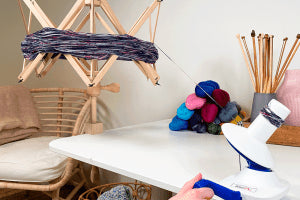Tervetuloa blogiin!

Opas: Näin kerit langan vyyhdinpuilla ja kerijälaitteella
Oletko kyllästynyt vyyhtien käsin kerimiseen? Sitten on aika tutustua tähän välineiden voimapariin: Vyyhdinpuihin ja kerijälaitteeseen. Tämän oppaan avulla opit kuinka näiden laitteiden avulla luot kauniita keriä helposti ja nopeasti. Ja mikä parasta, voit aloittaa neulomisen ja virkkaamisen nopeammin. 😍

Uutuus: Tapaa uusi Friends-sarja
Hurraaaaa! Uusi lankasarja on vihdoin nettikaupassamme! Uuden sarjan nimi on Friends, ja se sisältää upeita ja pehmeitä lankoja. Ja mikä parasta? Langat jakavat saman värikoodin, joten voit yhdistää eri materiaaleja mielesi mukaan.

Askel-askeleelta-opas: Näin virkkaat yksinkertaisen isoäidinneliön
Unelmoitko Granny Square-isoäidinneliöiden virkkaamisesta? Isoäidinneliöt eivät ole ollenkaan niin vaikeita - Ei edes vasta-alkajalle. Opi virkkaamaan neliöitä video-oppaalla ja ohjeella joka opastaa sinut askel askeleelta virkkaamaan näitä kauniita neliöitä. Varoitus: Voi olla että jäät koukkuun!

Rakastatko sinä myös isoäidinneliöitä? Inspiroidu seuraavaa projektiasi varten
Kiinnostus isoäidinneliöitä kohtaan kukoistaa jälleen. Tässä blogijulkaisussa voit löytää inspiraatiota seuraavaan projektiisi ja luoda hauskoja neliöitä joita voi yhdistää lukemattomasti. Opit virkkaamaan neljä erilaista Granny Squares-neliöitä.

Tutustu suunnittelijaan: Pica Pau (Joulu-mallisto)
Sukella Pica Paun hassuun maailmaan suunnittelija Yan Schenkelin kanssa. ✨

Kuinka pestä villalankaa? Askel askeleelta-opas
Opettele hoitamaan valmiit työsi oikein. 🫶

Superwash-villa - Mitä se on?
Pesukonepesu? Superwash tekee sen mahdolliseksi! 🧺✨



